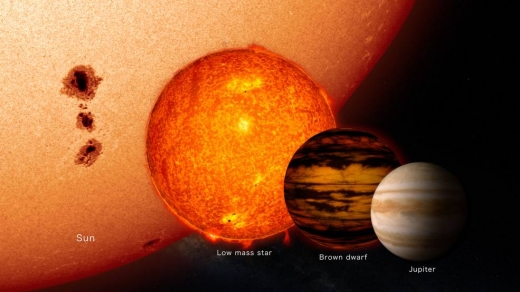A paper that crossed my desk this morning proves timely in light of our recent discussions about brown dwarfs. Specifically, the question of when to declare an object a planet or a brown dwarf has come up, with the cutoff often cited at about 13 Jupiter masses. Now I see that Johns Hopkins’ Kevin Schlaufman is proposing a cutoff somewhere closer to 10 Jupiter masses, but the idea takes us beyond mass as the determinant of the object’s status.

We tend to turn toward the IAU Working Group on Extrasolar Planets for our ideas on the planet/brown dwarf distinction, though the fact that we can find objects with 10 times Jupiter’s mass both in orbit around stars and also in isolation makes the definition a challenging one. The IAU has defined a planet as an object with a mass below the limiting mass for deuterium fusion that orbits a star or stellar remnant. Objects above this limiting mass have been defined as brown dwarfs, no matter how they formed or where they are located. This is where the 13 Jupiter mass cutoff comes from, although other models have also been proposed.
Image: Johns Hopkins astrophysicist Kevin Schlaufman has proposed a new definition of a planet. Credit: Johns Hopkins University.
But this gets tricky, because much depends on composition — the mass needed for deuterium fusion depends on the object. Under this definition, a metal-poor object of 13 Jupiter masses would be considered a planet, while a metal-rich object of the same mass would be considered a brown dwarf. Nor does this definition take into account formation models.
Schlaufman has made a close study of some 146 planetary systems in his efforts to distinguish between huge planets and tiny brown dwarfs. As the paper says:
This combined sample of 146 giant planets, brown dwarfs, and low-mass stars that have Doppler-inferred masses and transit solar-type primaries (most with homogeneously derived stellar parameters) is the best sample available to calculate the mass at which low-mass secondary companions no longer preferentially orbit metal-rich solar-type primaries.
Mass, in Schlaufman’s view, is simply not enough of a determinant when making the call between planet and brown dwarf. Instead, he proposes looking at the chemical composition of host stars. Giant planets will be found orbiting stars with high metallicity because planets like Jupiter form by building up a rocky core that is later enveloped by a gaseous envelope — this is core accretion. Gas giants are invariably found orbiting dwarf stars that are rich in metals.
Brown dwarfs and stars, on the other hand, form from the top down, clouds of gas collapsing to produce the object through the model referred to as gravitational instability. And indeed, we don’t see brown dwarfs necessarily associated with stars with high metal content. In Schlaufman’s study, objects more massive than 10 times Jupiter mass can be found near stars with varying degrees of metal content. The lack of correlation tells the tale.
Thus the paper:
Celestial bodies with M ? 10 MJup preferentially orbit metal-rich solar-type dwarf stars, while celestial bodies with M ? 10 MJup do not preferentially orbit metal-rich solar-type dwarf stars. A preference for metal-rich host stars is thought to be a property of objects formed like giant planets through core accretion, while objects formed like stars through gravitational instability should not prefer metal-rich primaries. As a result, these data suggest that core accretion rarely forms giant planets with M ? 10 MJup and objects more massive than M ? 10 MJup should not be thought of as planets. Instead, objects with M ? 10 MJup formed like stars through gravitational instability.

Image: This illustration shows the average brown dwarf is much smaller than our sun and low mass stars and only slightly larger than the planet Jupiter. Credits: NASA’s Goddard Space Flight Center.
Usefully, we will soon be able to test this prediction at a new level of precision. Schlaufman is saying that planets in the mass range of 1 to 10 Jupiters should preferentially be found around metal-rich solar-type dwarf stars, while brown dwarfs between 10 and 80 Jupiter masses should be found around solar-type dwarf stars that span the entire range of metallicity. The European Space Agency’s Gaia mission is expected to find and characterize 21,000 ± 6000 giant planets and brown dwarfs, a sample large enough to put Schlaufman’s theories to the test.
The paper is Schlaufman, “Evidence of an Upper Bound on the Masses of Planets and Its Implications for Giant Planet Formation,” published online by The Astrophysical Journal 22 january 2018 (abstract/preprint).



A different chemical composition can result in a different density and mass. If we use deuterium fusion into helium one of the criteria of a brown dwarf then, mass must be the foundation though since fusion is dependent on temperature and inner pressure which is based on the mass. According to the literature it is debatable what the lower end of the mass is where deuterium burning begins.
The proton proton chain begins with deuterium fusion. Two protons collide with high velocity and the proton repulsion of electromagnetic force is overcome. One of the protons turns into neutron with the emission of a positron and neutrino. Then deuterium collides with another proton and the electromagnetic repulsion is overcome, the strong nuclear force takes over and they combine into helium three with the emission of a gamma ray.
It is the gravitational energy which causes fusion through the kinetic energy of particles in the core. The particles are sped up in the core and collide at high velocity just like in the core of a star. One needs 79 Jupiter masses and a temperature of ten million kelvin of course to initiate the fusion of helium three into helium four.
In which case,this is not a planetary system. Hmmm…
Along the range from big planets to binaries, boundaries based on physical processes such as nuclear fusion may promote orderly thinking, but utilitarian criteria – how such objects interact with the rest of systems may also be significant in the order of the universe.
Humans just have to put everything in specific little boxes with labels, don’t they? Even when they don’t fully grasp the situation. This also shows just how much the Universe has no interest in catering to this human need for order among others.
I’m glad that Kevin Schlaufmann is factoring the method of formation into the definition determination criteria. Back in the late 1970s (as Robert M. Powers recorded in his book “Planetary Encounters”), this was a question concerning Jupiter, too; scientists weren’t sure–based on the Pioneer 10 and 11 data, or even the Voyager 1 and 2 data–if Jupiter formed by accretion or by dynamical collapse (also called gravitational instability), and:
If dynamical collapse was the mechanism, that theory suggested that a major, latter part of proto-Jupiter’s collapse could have occurred rapidly, in as little as three months! Back then, the way that Jupiter formed also had ramifications for stellar formation (particularly where small, low-mass stars were concerned), because they still weren’t sure if Jupiter might have been a proto-star that *just* fell short of the minimum mass to sustain continuous deuterium “burning” nuclear fusion (occasional, episodic deuterium fusion was considered possible).
Is this all being thought of to linearly, it is assumed nature uses one process or the other, but nature always seems, like electricity, to choose the path of least resistance.
There is no reason to think that core acretion is not used more or less than is currently thought. Whilst we have models of how stars form, for all we know they could all start with core acretion and that gravitational instability is a red herring.
I would agree this unlikely, my gut is that nature uses both and which depends on the physical situation at that time.
Personally, I feel the line between superplanets and brown dwarves is a blurry one without true definition.
That is an interesting thought, James. I can see how a star containing large amounts of vaporized silicates and metals (which might even reform silicate molecules, in the cooler outer layers of red dwarf stars) might begin as a planetesimal, a relatively small cloud of silicate and metal grains (with hydrogen between them) that gradually “compacts itself” and slowly attracts–like a growing proto-planet–more hydrogen via its growing mass and gravity, until it collapses to the density needed to light up as a new star, and:
I wonder if there is a “metallicity” (elements heavier than hydrogen and helium, not all of which are really metals) limit for stars, beyond which a star could contain too much “metal” to light up the fusion reactions, or to undergo nuclear fusion steadily and stably? (There is an upper mass limit, above which a proto-star will simply explode rather than start sustained [though intense and high fuel consumption rate] fusion as an O Class star.)
Intuitively, the idea that the Jupiter system including Saturn began with an accretion disk makes sense since it is like a mini solar system with all it’s moons which is the generally accepted present view by astrophysicists. The philosophy of science is that it’s principles are mind independent and objective since it’s physical principles or first principles are based an order that controls our universe and makes it predictable; Consequently, it’s nice to know that any ET’s will have to use the same principles and even the same technology such as that which is used for remote sensing and space travel.
Hard to define, Jupiter also did burn a bit of heavy hydrogen in early age.
Image is not correct, many Brown dwarfs have exactly same size as Jupiter.
Astronomers observe huge flares on a young brown dwarf
June 6, 2018 by Tomasz Nowakowski, Phys.org report
The strongest superflare observed on CFHT-BD-Tau 4. The blue dots represent the observed data. The dashed vertical lines represent the start and end times of flare. Credit: Paudel et al., 2018.
Using Kepler, astronomers have spotted two superflares on a very young brown dwarf known as CFHT-BD-Tau 4. The two superflares turn out to be the strongest flares observed on any brown dwarf so far. The finding is detailed in a paper published May 28 on the arXiv pre-print server.
https://phys.org/news/2018-06-astronomers-huge-flares-young-brown.html